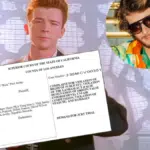Actor Christopher Walken painted over a Banksy original on “The Outlaws.” Could the street artist claim a violation of his moral rights?
Actor Christopher Walken has a unique talent. He’s somehow able to come across as a total badass while at the same time looking like a nervous wreck. It’s quite a feat, which is why I think it would be so entertaining to watch him face off in a courtroom under cross examination by…wait for it…Banksy’s copyright lawyer.
In what possible world would this happen, you ask?
Well, if I’m being perfectly honest, it probably wouldn’t. But hear me out, because we’ve actually never been closer to what would be, without question, the lawsuit of the decade.
Walken made international headlines last week when he painted over original Banksy artwork in the season finale of the BBC comedy-drama series “The Outlaws,” which is set in Banksy’s hometown of Bristol, England. (The series will be available to U.S. audiences on Amazon Prime early next year.)
“The Outlaws” follows a gang of seven lawbreakers who are sentenced to community service. During the finale, Walken’s character Frank Sheldon is tasked with painting over graffiti on the side of a building. When he comes across a section with Banksy’s signature and trademark rat motif, Frank asks his probation officer if he should paint over it.
“Council said paint over any graffiti, so crack on.”
“It’s awfully good,” Frank protests.
“Less debating, more painting,” she retorts.
And with six strokes of a roller brush shot in one take, the Banksy is ruined.
Big Talk Productions, the show’s production company, confirmed that the artwork was “an original Banksy,” and that Walken painted over it during filming, “ultimately destroying it.” According to the New York Times, Big Talk offered no more details, and a representative for Banksy didn’t respond to a request for comment.
To be clear, there’s no E&O policy in the world that would cover the destruction of a work of art potentially worth millions of dollars—so there’s no doubt Banksy was all in on the show’s gag. But what if he weren’t? Could the enigmatic street artist sue the BBC, Big Talk Productions and potentially even Christopher Walken himself for the destruction of his art?

I’ve written before on Copyright Lately about the Visual Artists Rights Act (VARA), a provision of the United States Copyright Act that allows artists of works of “recognized stature” to sue for the intentional or grossly negligent destruction of their works. VARA has proven to be a powerful tool against the destruction of street art in the United States. Case in point: Last year, the Second Circuit affirmed a whopping $6.75 million judgment in a landmark VARA case against a real estate developer who willfully whitewashed 45 works of graffiti art at the 5Pointz property in Queens.

VARA only applies to works of visual arts in the United States, so it wouldn’t cover a Banksy work located in England. Historically, European courts have been receptive to the concept of “moral rights,” which protect the attribution of an artist and the integrity of a protected work. But what about the United Kingdom?
The UK Copyrights, Designs and Patents Act of 1988 (CDPA) does provide some protection for moral rights, including the right in certain circumstances for artists to object to the “derogatory treatment” of their works. Under the CDPA, “the treatment of a work is derogatory if it amounts to distortion or mutilation of the work or is otherwise prejudicial to the honour or reputation of the author or director.”
Common sense would suggest that if distortion or mutilation is prohibited, then destruction would be as well. But interestingly, most UK copyright experts don’t think that’s the case. Per the statute, while “derogatory treatment” applies to unauthorized additions, deletions or alterations to artworks, it does not protect against the wholesale destruction of a work.
According to UK street art expert Enrico Bonadio of the City Law School, one UK decision, Harrison v. Harrison, suggested in dicta that the concept of “treatment” under the CDPA might include the destruction of a work. But that case involved literary works, and there’s a dearth of UK case law on point, especially in the context of street art. Bonadio also notes that the CDPA fails to incorporate certain Berne Convention moral right provisions that could allow for a broader right to oppose destruction.
Another potential problem for Banksy is his steadfast decision to remain anonymous, which could make it difficult for him to show that any particular “derogatory treatment” is prejudicial to his “honour or reputation,” as required by the CDPA. In other words, can Banksy’s reputation really be said to suffer damage if no one knows who he actually is?
In addition, based on some of his public comments, Banksy doesn’t seem to be particularly interested in vindicating any right to prevent destruction that he might otherwise possess. In a 2010 interview with “Time Out London,” he pronounced that “if you’re the type who gets sentimental about people scribbling over your stuff, I suggest graffiti is probably not the right hobby for you.” (I should point out that this comment followed Banksy’s destruction of graffiti art painted by another artist with whom Banksy was feuding.)
And of course, there’s the time that Banksy destroyed one of his own pieces using a shredder incorporated into the artwork’s frame. The shredder was triggered mere moments after “Girl With Balloon” was sold at a Sotheby’s auction in October 2018.
So, alas, watching Banksy v. Walken play out in in a courtroom will, unfortunately, likely remain a pipe dream. And as for the Walken whitewash? Ironically, it’s probably only made Banksy’s art more valuable. After all, while “Girl With Balloon” sold for $1.4 million before it was shredded, the piece (later retitled “Love is in the Bin”) was subsequently reauctioned just three years later. The new sales price? $25.4 million.
As always, let me know what you think in the comments below or on my social media accounts @copyrightlately. Have a great week!







5 comments
Banksy did the artwork specifically for the show. So obviously no lawsuit would hold its weight.
Well done Mr Walken! Somehow I don’t feel Banksy could even afford a lawyer let alone go up against a Hollywood Legend.
Banksy art is rubbish. Here in Norfolk and Suffolk plenty of street artists have proven to be far greater. I call Banksy art “Stencil Art” because that’s what it looks like.
Pure rubbish basically. But morons will pay through the roof for stuff you throw in the bin.
All these articles putting a ridiculous price tag on this piece. Banksy’s on the side of a building typically fetch low to mid six figures, this one is pretty basic, stop talking about millions of pounds worth.
To answer the headline. Nope because Banksy was commissioned to paint the piece on the back of the community centre at Sea Mills as part of the production and knew what would happen to it.
I’d love to hear how that actually went down. Logistically, I’m not sure how an anonymous artist would show up to do a commissioned piece for TV show. Do you have any further information?